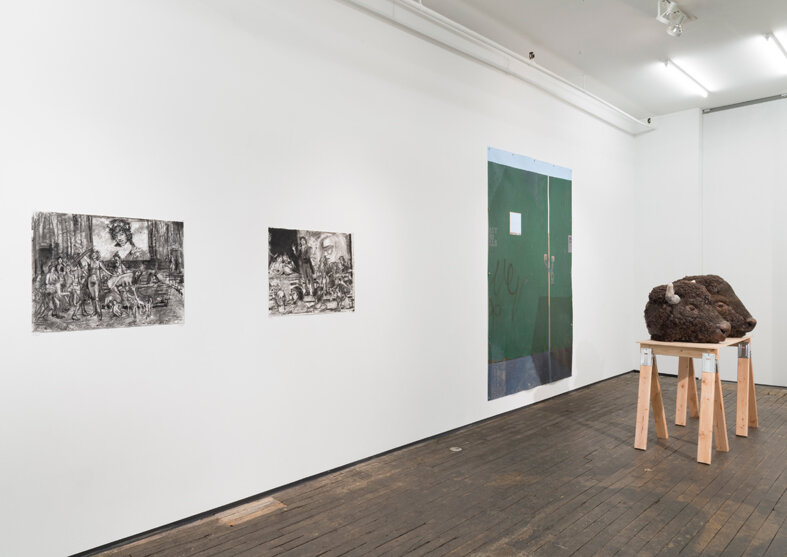
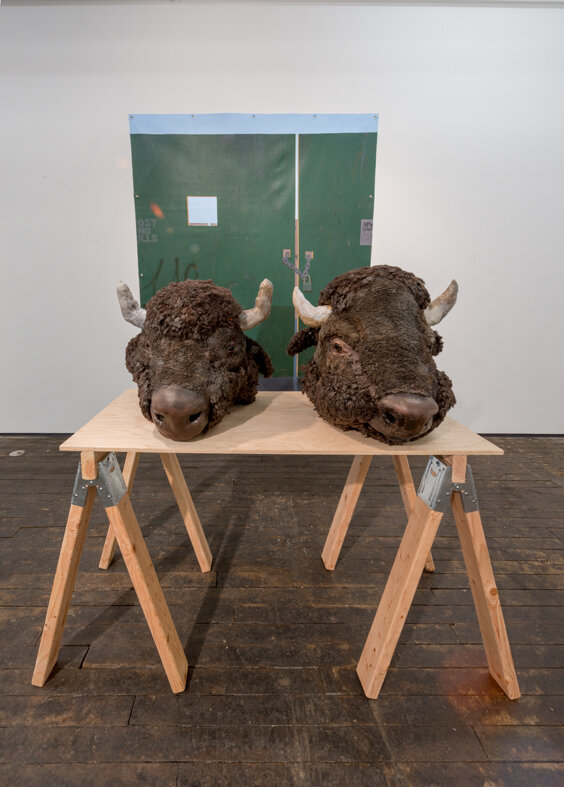

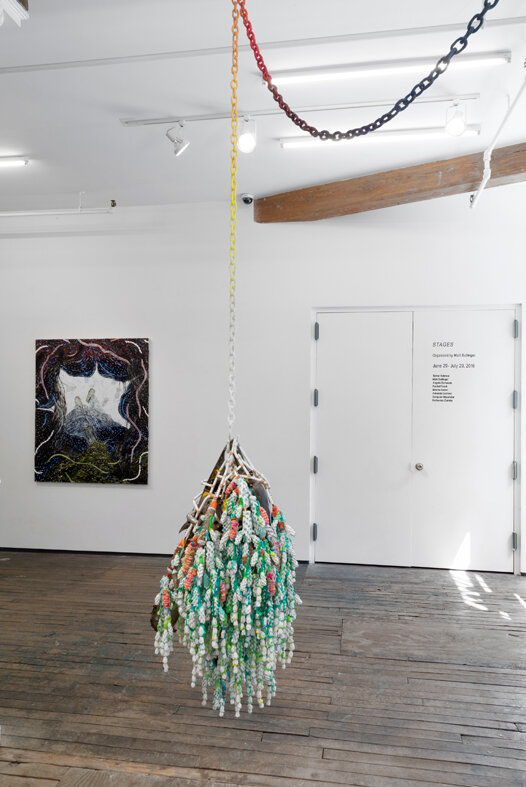
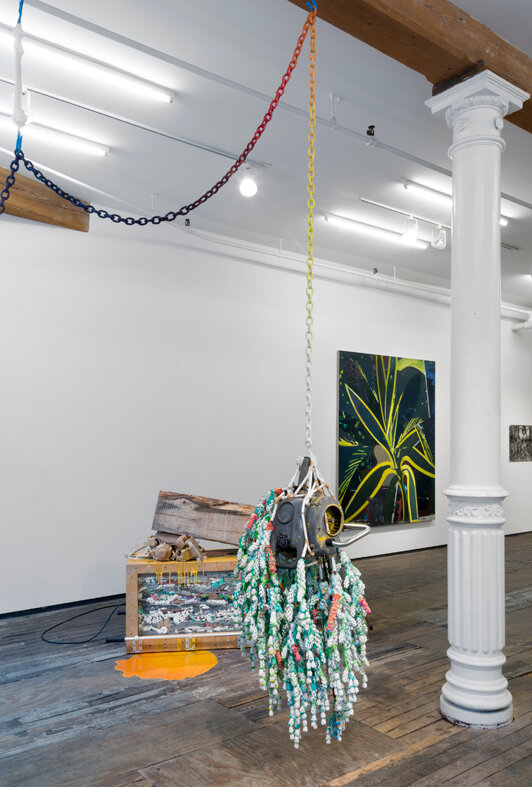
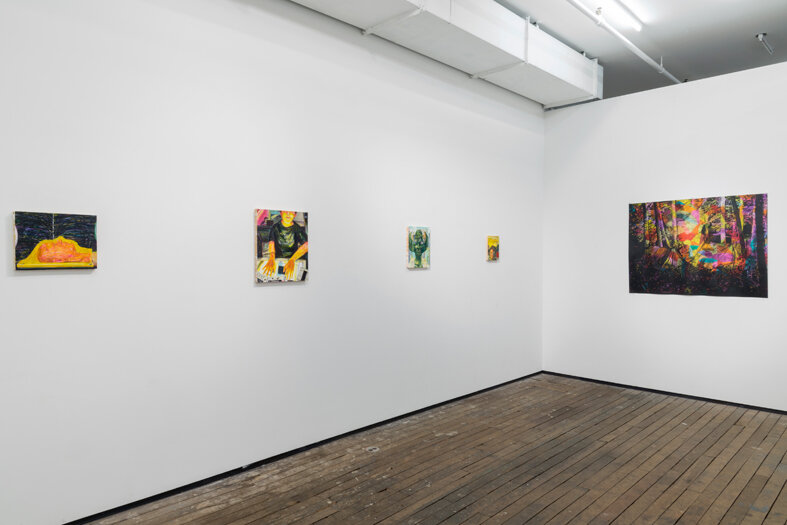
Stages, organized by Matt Bollinger
June 29 - July 29, 2016
Taylor Baldwin, Matt Bollinger, Angela Dufresne, Rachel Frank, Meena Hasan, Amanda Lechner, Sangram Majumdar, Katharina Ziemke.
Last summer I traveled to Paris for an exhibition. My wife and her family came along and took us all to the Opera National de Paris at the Palais Garnier for a performance of Gluck’s Alceste directed by Olivier Py.(1) When we took our seats, I was surprised to see an immense drawing in chalk depicting the exterior of the Palais Garnier that stretched the height and width of the stage. Py’s frequent collaborator, Pierre-André Weitz, created the moveable sets out of flat, blackboard-like surfaces, which artists covered with drawings that they then erased and changed all while the performers acted and sang. The way these staging elements and theater technicians emerged from behind the curtain and simultaneously brought the facade of the opera house indoors, created a double narrative with the 18th century story.
When back in Brooklyn and while still thinking about those parallel narratives, I visited Rachel Frank’s studio where I saw two or three of her large animal masks stored on shelves. She created these as part of her on-going Rewilding Project, but seeing the masks in storage, they took on a potential energy suggestive of other narratives and contexts. They bring to mind species once far-ranging, hunted to near-extinction, conflicts between colonial power and indigenous peoples (as Rachel points out in a statement about the project)(2), and mythic human animal hybrids reminiscent of Goya’s prints and Greek myth. While inert, they double narratively as a vehicle for impromptu performance and finely wrought sculpture.
Angela Dufresne’s drawings offer a parallel universe to that of her paintings. Whereas her paintings give in-the-flesh views of her grand dames, beast-women, hornball heroes, ass-kickers, boot-lickers, and pissers, her small-scale drawings open expansive spaces where the many facets of her drama can play out at once. Movie theaters, Roman arches, and construction sites all serve as settings and each modifies her cast of characters’ behavior (or misbehavior). In the paintings the figures have the sculptural presence of a tableau vivant staged moments after the action has happened. When Dufresne draws, she captures the events as they occur. In one untitled drawing, Prince looks out from a movie screen, while the audience of revelers, including a multi-teated woman, several transgender individuals, and Nebuchadnezzar in beast form, all cavort. In another Gena Rowlands appears on the big screen in a crowded opera house/theater. If Rowlands in A Woman Under the Influence is Dufresne’s muse—a woman struggling to shake off patriarchy’s brutal, limiting definitions—then the theater is her ideal setting. Theatrics (and the immediacy of drawing) gives Dufresne the chance to test and break boundaries. Her theaters also bring together difference: performer and spectator; female and male; human and animal; and good and bad taste.
In recent years Katharina Ziemke has begun collaborating with theatrical productions, designing set elements and painting backdrops, but her work has always contained her distinct form of introverted drama. Often working from old photos and film stills, she creates scenes that have a flash-photo-meets-magic-lantern lighting. In her scratched wax drawing, Nocturnal Gathering, she depicts a campground setting that implies narrative possibilities. What could easily be a pastoral image of a weekend outing, takes on sinister implications because of Ziemke’s method of first applying bright colors and then covering them over with black wax. By scratching back through the wax she peels away the shadow to reveal the formerly hidden light. Just the same, the weight of the black wax gives the kaleidoscopic color a distant character like hearing the sounds of a good time echoing through the woods at night.
Meena Hasan’s paintings adopt unusual points of view that draw attention to the first person. In Walking in the Snow, I am outside on a winter day, wrapped in layers and so blasted by snow that I can only look at the ground in front of me, one step at a time. The dramatic doubling that occurs with this painting implicates me: when I see out of the eyes of another in this way, I am them, however briefly. At the same time, the twist of garments and hair that fill the margins of this image take me out of the body and suggest a night sky. The winter coat, patterned with snow, expands into a deep blue night. While the island of snowy ground presses forward, this cosmos expands outward beyond the constraints of the frame.
Similarly in the compact frame of her tempera paintings, Amanda Lechner portrays the authority of scientific “truth” as suspect. Inflected with sci-fi conspiracies and pseudo science, she paints narratives where the boundaries blur. Her combination of quantum physics and speculative fiction suggests that the unifying force in both is the imagination. At first glance RadioSurgeryGammaKnife seems to be a science fiction picture showing a bald man engaged in some cosmic contemplation or astral projection. After Googling the title, I learned that Radiosurgery performed with the Gamma Knife is a kind of brain surgery for patients with brain tumors during which many relatively harmless beams of radiation are shot into the brain, converging on a single point where their additive force can serve to diminish or even eliminate the tumor(3). Lechner’s use of saturated and unnatural colors as well as her active, crisscrossing brushwork suggests her fascination with the new tools, technologies, and discoveries in science all while imagining future possibilities both thrilling and terrifying.
Taylor Baldwin’s work, motherfucker/redeemer, evokes complicated material histories where nothing is innocent. In the past his sculptures’ encyclopedic material lists have led him to publish booklets to allow for the elaborate backstory of how he researched, collected, bartered, stole, or found the materials. motherfucker/redeemer features two chainsaws, an actual McCulloch 3-25 overgrown with handmade cacti and a one-to-one replica made from corrugated cardboard. As the first one-person chainsaw, the 3-25 symbolizes American autonomy while suggesting bleaker narratives of deforestation and waste. In the sculpture, the real saw (a substrate for desert plants) is counter-balanced against a rough-hewn log, which in turn crushes the 3-25’s replica (oozing wood glue). Beneath, encased in concrete, Baldwin has compressed all of the sculpture’s scraps and leftovers into what looks like a geological cross-section—the “soil” for the sculpture, but also a monumental tomb.
Sangram Majumdar has a dollhouse. He has plants cut from paper. The dollhouse, half disassembled and put back together haphazardly, acts as his stage; the paper cut-outs are his set-pieces. The oil paintings he makes from this set are both perceptually vivid and slippery to name. A form will evoke or resemble without being or without being exclusively. In Starburst, leaf forms spiral from a central hub while looking like a pattern on a textile. In the painting’s negative spaces, Majumdar creates an expansive atmosphere where neon lights wink on and off (evoking the way light moves along my car’s window at night). By hinting that the sources for his paintings are constructions, he performs the making of the painting: this flat plane torques back from the surface of the painting where it applies pressure on another color-shape. In doing so that second form opens up into that urban sky, alight with fireworks.
Like the other works in the show, I wanted my painting, Work in Progress, to have several possible lives. I created it both as a stand-alone painting and as a backdrop for Rachel Frank’s masks. As in Py’s staging of the Gluck opera, I see my “backdrop” as a moveable setting that benefits from its proximity to Frank’s sculptures. Where the staging of Alceste brought together myth and the real-world-setting of the Palais Garnier, our works combine the idea of the historical landscape with an image suggesting the present day urban environment in Brooklyn—a terrain contested by conflicting view points and material realities. Together our pieces stage a new narrative that teases out different experiential implications than they do alone. The works in this exhibition combine from their original contexts in a moveable experience; each performs individually, but also joins in chorus with the other works in the show. The ensemble cast questions how narratives, fictional and non-fictional, are staged, and examines how the construction of these stories, rather than splintering the viewer’s capacity to suspend his or her disbelief, in fact draw together pluralistic narratives otherwise hidden behind theatrics.
—Matt Bollinger
WORKS CITED
1. Gluck, Christoph Willibald. Alceste. Opera National de Paris. Directed by Olivier Py. Sets and costumes by Pierre-André Weitz, 2015.
2. Frank, Rachel. “Rewilding Projects.” <http://www.rachelfrank.com/Rewildin...> web. 14 June 2016.
3. “Brain stereostatic radiosurgery.” Mayo Clinic. Mayo Clinic, March 25, 2015 Web. 16 June 2016.
